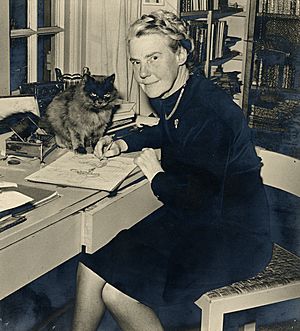Rie Cramer facts for kids
Quick facts for kids
Rie Cramer
|
|
|---|---|

Rie Cramer in 1947
|
|
| Born | Marie Cramer 10 October 1887 Sukabumi, Dutch East Indies |
| Died | 16 July 1977 (aged 89) Laren, Netherlands |
| Pen name | Rie Cramerová, Marc Holman, Rie Verkade-Cramer, Annie Smit |
| Occupation | Illustrator, writer |
| Nationality | Dutch |
| Alma mater | Royal Academy of Art, The Hague |
| Period | 1906-1977 |
| Genre | Children's literature |
Marie "Rie" Cramer (born October 10, 1887 – died July 16, 1977) was a Dutch writer and a very busy illustrator of children's books. Her unique style is famous from the time between the two World Wars. For many years, she was a main artist for Zonneschijn (Sunshine). This was a popular Dutch magazine for young people. She also wrote plays using the pen name Marc Holman. During World War II, some of her work was banned. This was because it spoke out against National Socialism. She even wrote for a secret newspaper during the war.
Contents
Early Life and Learning
Rie Cramer was born in Sukabumi. This place was then called the Dutch East Indies. Her father, Hendrik Cramer, was a ship captain. Her mother was Elisabeth Frederica Schenk. In 1896, Rie moved to the Netherlands. She went with her mother and youngest sister. They settled in a town called Arnhem. Her aunt Gesine, who was an artist, encouraged her. Rie began to study drawing in Arnhem.
In 1904, her father joined the family in the Netherlands. They then moved to The Hague. Rie studied at the Royal Academy of Art. She was a student there from 1905 to 1907.
A Career in Art
Rie Cramer is most famous for her many illustrations. She drew pictures for children's books. She also wrote some of these books herself. But she also illustrated books for adults, including works by William Shakespeare. For many years, she and Anton Pieck were the main artists for Zonneschijn. This magazine started in 1924. It became the most important youth magazine in the Netherlands. It stopped being published in 1943.
Rie also designed sets and costumes for plays. She even worked on the Dutch display at the 1939 New York World's Fair. She started her career as an illustrator while still a student. Her early drawings were inspired by artists like Edmund Dulac and Arthur Rackham. They had a special Art Nouveau look.
Changing Art Style
After the 1920s, her drawings became simpler. They were less detailed and more direct. The colors she used also became brighter. This was because of her work on stage costumes and sets. From the 1930s, she drew fewer children's books. Instead, she started writing books for older teens. She also made art pottery. She did this with her friend Fransje Carbasius. They had met at the art academy.
During World War II
During World War II, Rie kept working as an artist. She also designed for the theater. She wrote two plays using the name Marc Holman. Two of her earlier books for adults were banned. The Germans banned them because she had criticized National Socialism in them. She joined the resistance movement. This meant she helped people who were hiding from the Germans. She also secretly published poems against the Germans. These poems appeared in Het Parool. This was the biggest secret newspaper in the Netherlands. These poems were later put into a book in 1945. It was called Verzen van verzet (Poems of Resistance).
After the War
After the war, her work was translated into many languages. These included English, German, French, and Danish. In 1954, she wrote a radio play with 42 parts. That same year, she left the Netherlands. She moved to the Spanish island of Mallorca with some friends. She continued to make pottery and tiles there. She also wrote three books about the island. In 1971, she became unwell. She had to return to the Netherlands. She passed away in 1977. Her books are still being printed today.
Rie Cramer is seen as one of the most important Dutch women illustrators. This is especially true for children's books between the two World Wars. Other important artists were Henriette Willebeek le Mair and Nelly Bodenheim. Even though she was successful, some critics did not like her style as much. They thought her drawings were a bit stiff and too sweet. But most critics agree that her illustrations were very important. They helped define the art style of that time.

